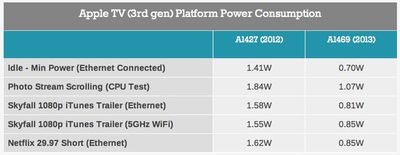Tweaked Apple TV Offers 'Significant' but Nearly Invisible Power Savings With More Efficient Chip Designs
Following Chipworks' examination of the new A5 chip found in Apple's tweaked Apple TV, AnandTech has performed its own analysis of the device. While many of the A5 chip details have already been covered, AnandTech focuses more on the device as a whole, and interestingly finds that the internal changes have yielded a significant decrease in power consumption compared to its predecessor.
The power savings are nothing short of significant. The previous generation Apple TV wasn’t really a power hog, with platform power maxing out at around 1.6W, but the new model tops out at just a watt. Overall the power savings seem to be around 800mW across the board.
With no change to process technology, I can only assume that the reduction in power consumption came from other architectural or silicon optimizations.

Of course, AnandTech also notes that the power savings are essentially invisible to users given how little power the set-top box used to begin with.
Assuming you’re using the Apple TV for watching video 8 hours a day, every day of the year, you’d save about $0.26 per year on your power bill (assuming $0.11/kWh). You’d break even on the $99 cost of a new Apple TV in about 385 years. Maybe by then we’ll actually have a true replacement to cable TV.
AnandTech also measured Wi-Fi performance on the tweaked Apple TV given that Apple has moved to a new Broadcom Wi-Fi chip and gone back to a one-antenna layout from the two-antenna configuration used in the previous model. Testing revealed that Wi-Fi range and performance is essentially identical between the old and new hardware.
Apple's reasons for introducing a brand-new chip design for the relatively low-volume Apple TV remain unclear, with AnandTech summarizing some of the recent speculation that Apple may be trying to shave costs by stripping out unnecessary components of the A5 or testing the new chip ahead of a broader rollout in other products.
Popular Stories
Apple's next-generation iPhone 17 Pro and iPhone 17 Pro Max are less than three months away, and there are plenty of rumors about the devices.
Apple is expected to launch the iPhone 17, iPhone 17 Air, iPhone 17 Pro, and iPhone 17 Pro Max in September this year.
Below, we recap key changes rumored for the iPhone 17 Pro models:Aluminum frame: iPhone 17 Pro models are rumored to have an...
The long wait for an Apple Watch Ultra 3 appears to be nearly over, and it is rumored to feature both satellite connectivity and 5G support.
Apple Watch Ultra's existing Night Mode
In his latest Power On newsletter, Bloomberg's Mark Gurman said that the Apple Watch Ultra 3 is on track to launch this year with "significant" new features, including satellite connectivity, which would let you...
The upcoming iPhone 17 Pro and iPhone 17 Pro Max are rumored to have a slightly different MagSafe magnet layout compared to existing iPhone models, and a leaked photo has offered a closer look at the supposed new design.
The leaker Majin Bu today shared a photo of alleged MagSafe magnet arrays for third-party iPhone 17 Pro cases. On existing iPhone models with MagSafe, the magnets form a...
The iPhone 17 Pro Max will feature the biggest ever battery in an iPhone, according to the Weibo leaker known as "Instant Digital."
In a new post, the leaker listed the battery capacities of the iPhone 11 Pro Max through to the iPhone 16 Pro Max, and added that the iPhone 17 Pro Max will feature a battery capacity of 5,000mAh:
iPhone 11 Pro Max: 3,969mAh
iPhone 12 Pro Max: 3,687mAh...
iOS 26 and iPadOS 26 add a smaller yet useful Wi-Fi feature to iPhones and iPads.
As spotted by Creative Strategies analyst Max Weinbach, sign-in details for captive Wi-Fi networks are now synced across iPhones and iPads running iOS 26 and iPadOS 26. For example, while Weinbach was staying at a Hilton hotel, his iPhone prompted him to fill in Wi-Fi details from his iPad that was already...
Apple today seeded the second betas of upcoming iOS 18.6 and iPadOS 18.6 updates to public beta testers, with the betas coming just a day after Apple provided the betas to developers. Apple has also released a second beta of macOS Sequoia 15.6.
Testers who have signed up for beta updates through Apple's beta site can download iOS 18.6 and iPadOS 18.6 from the Settings app on a compatible...
Apple's position as the dominant force in the global true wireless stereo (TWS) earbud market is expected to continue through 2025, according to Counterpoint Research.
The forecast outlines a 3% year-over-year increase in global TWS unit shipments for 2025, signaling a transition from rapid growth to a more mature phase for the category. While Apple is set to remain the leading brand by...
Apple is developing a MacBook with the A18 Pro chip, according to findings in backend code uncovered by MacRumors.
Subscribe to the MacRumors YouTube channel for more videos.
Earlier today, Apple analyst Ming-Chi Kuo reported that Apple is planning to launch a low-cost MacBook powered by an iPhone chip. The machine is expected to feature a 13-inch display, the A18 Pro chip, and color options...





















